(7) Changes to the Carbon Cycle over time
1/49
There's no tags or description
Looks like no tags are added yet.
Name | Mastery | Learn | Test | Matching | Spaced |
|---|
No study sessions yet.
50 Terms
Causes
Physical Causes
Human Causes
Physical Causes of Change
External Forces:
- solar energy
- orbital forcing
Internal Forces:
- volcanic eruptions
- wildfires
- el nino
External forces
= natural climate change
influence the carbon cycle from the outside of the system
Variations in solar energy
... occurs over decades
= Solar waves reach earth's atmosphere are either reflected or absorbed
- reflected = short wave radiation
... contributes to the albedo effect
- absorbed = long wave radiation
... absorbed by oceans, gases, surfaces, etc.
=> natural greenhouse effect
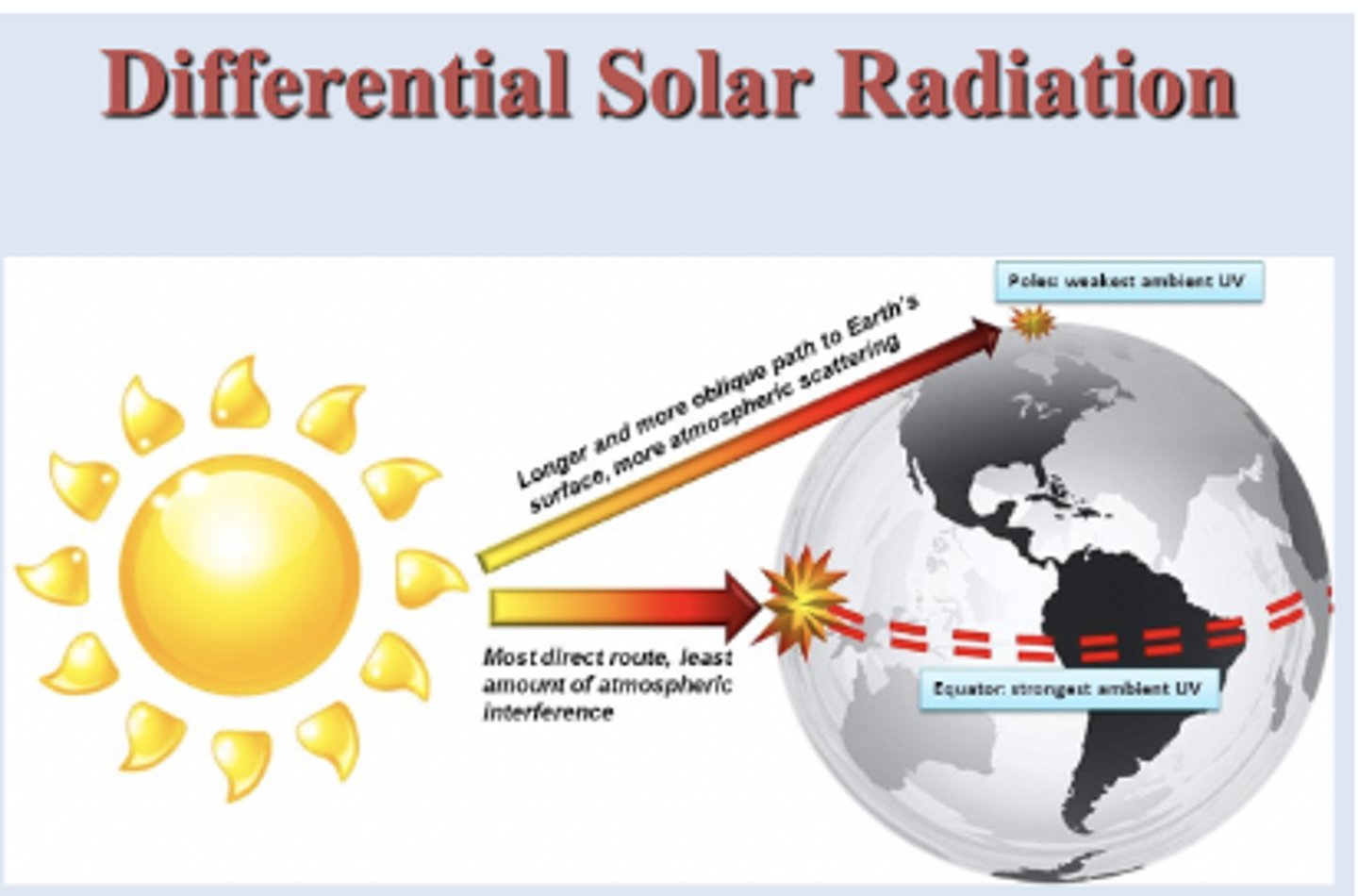
Global energy budget
= the balance between the energy that earth absorbs from the sun and the energy that is reflected back out to space
Climate forcings upset global energy budget and cause climate change
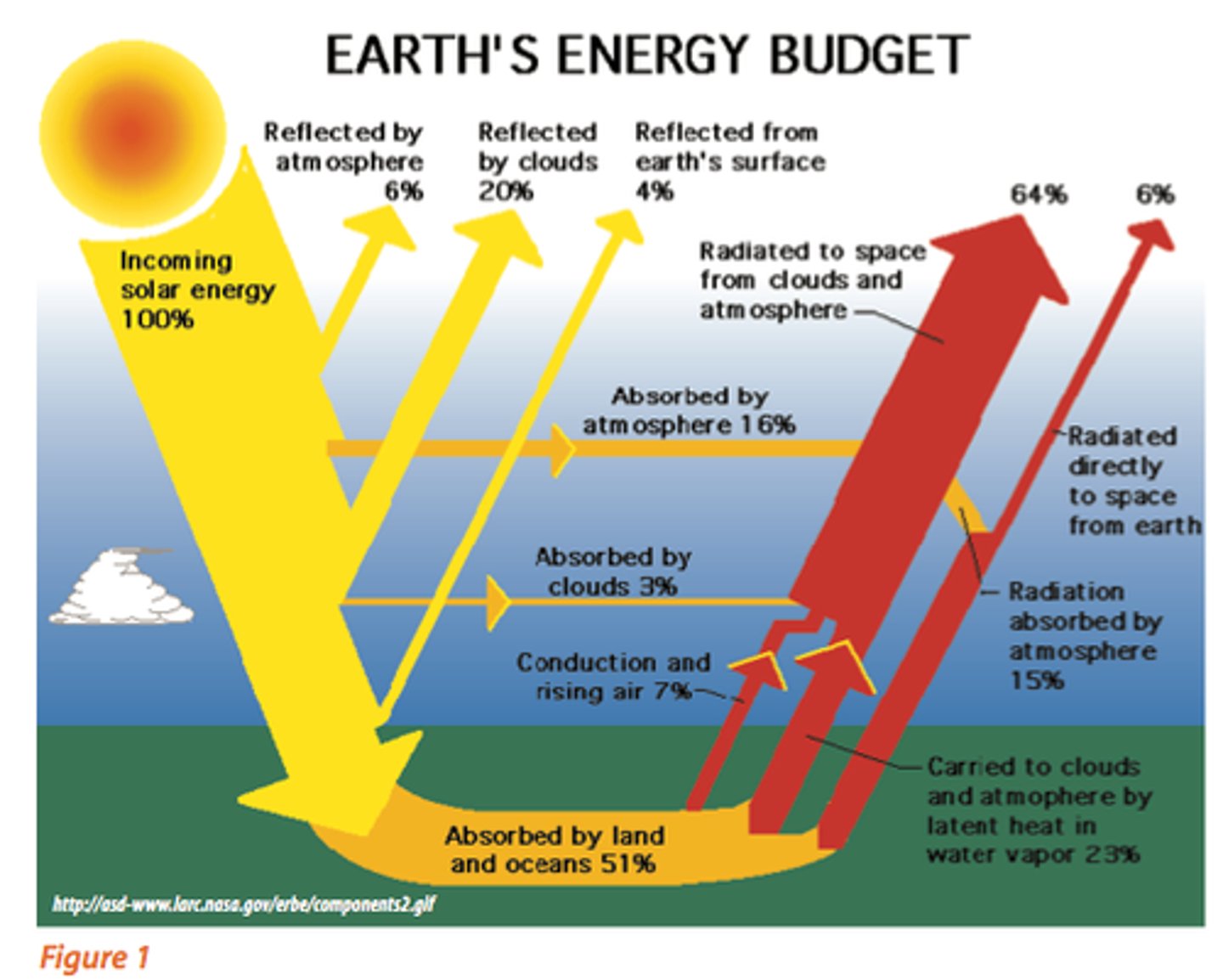
Sun Spots
- Some scientists believe that climate change is due to changes in the sun's activity
- 11 year solar cycle where sun spot numbers peak every 11 years
... studied ice cores and found concentrations of dust from storms which varied with the 11 year solar cycle
- More sunspots = warmer earth
- Sun spots are cooler but are accompanied by hotter, brighter boundaries (faculae)
- Cause overall brightness of sun to increase by 0.1% at visible wavelengths, and more at UV wavelengths
e.g.,
Maunder minimum
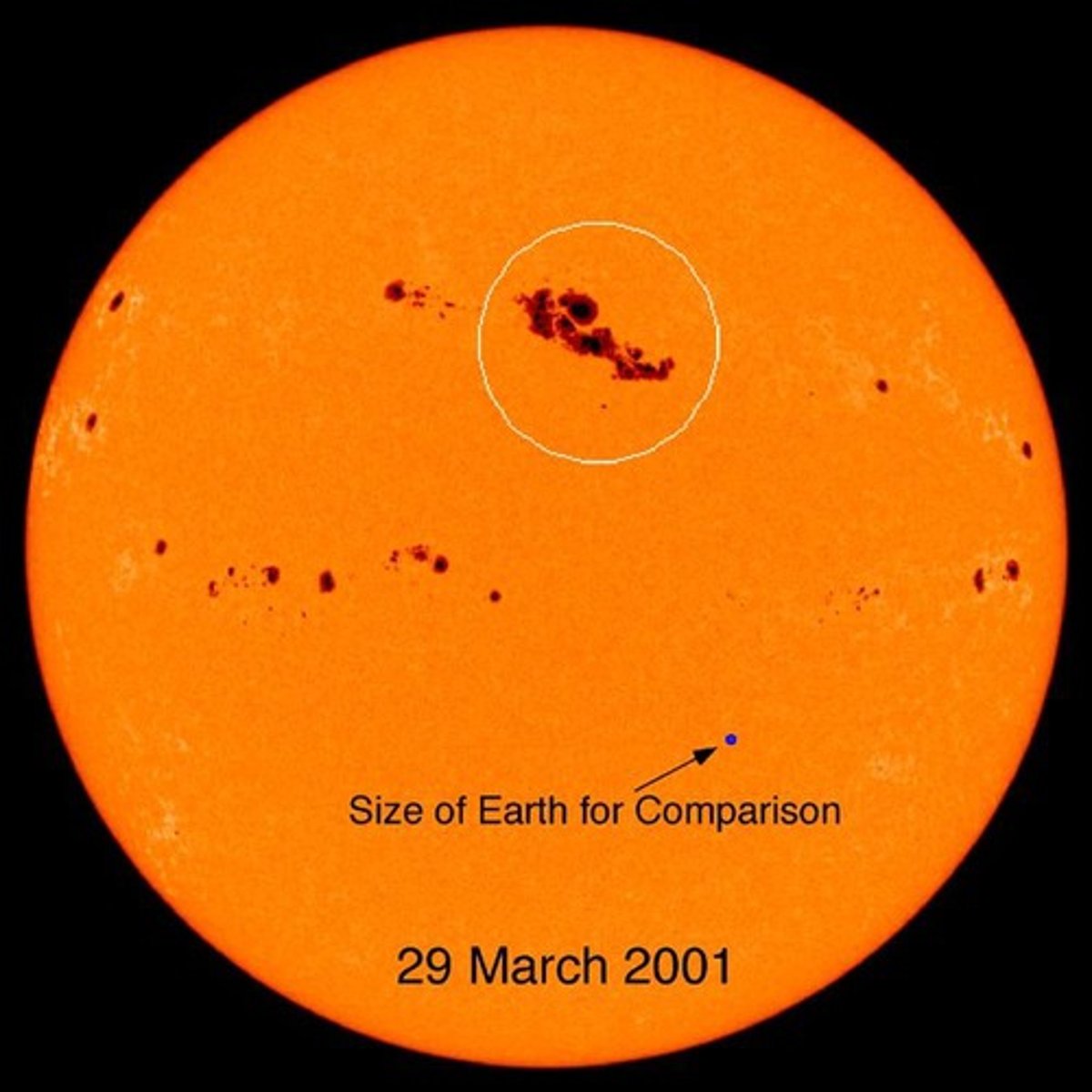
Maunder Minimum
= colder winters and overall atmosphere in 17th century
... due to fewer sun spots on the surface of the sun, leading to colder weather on earth
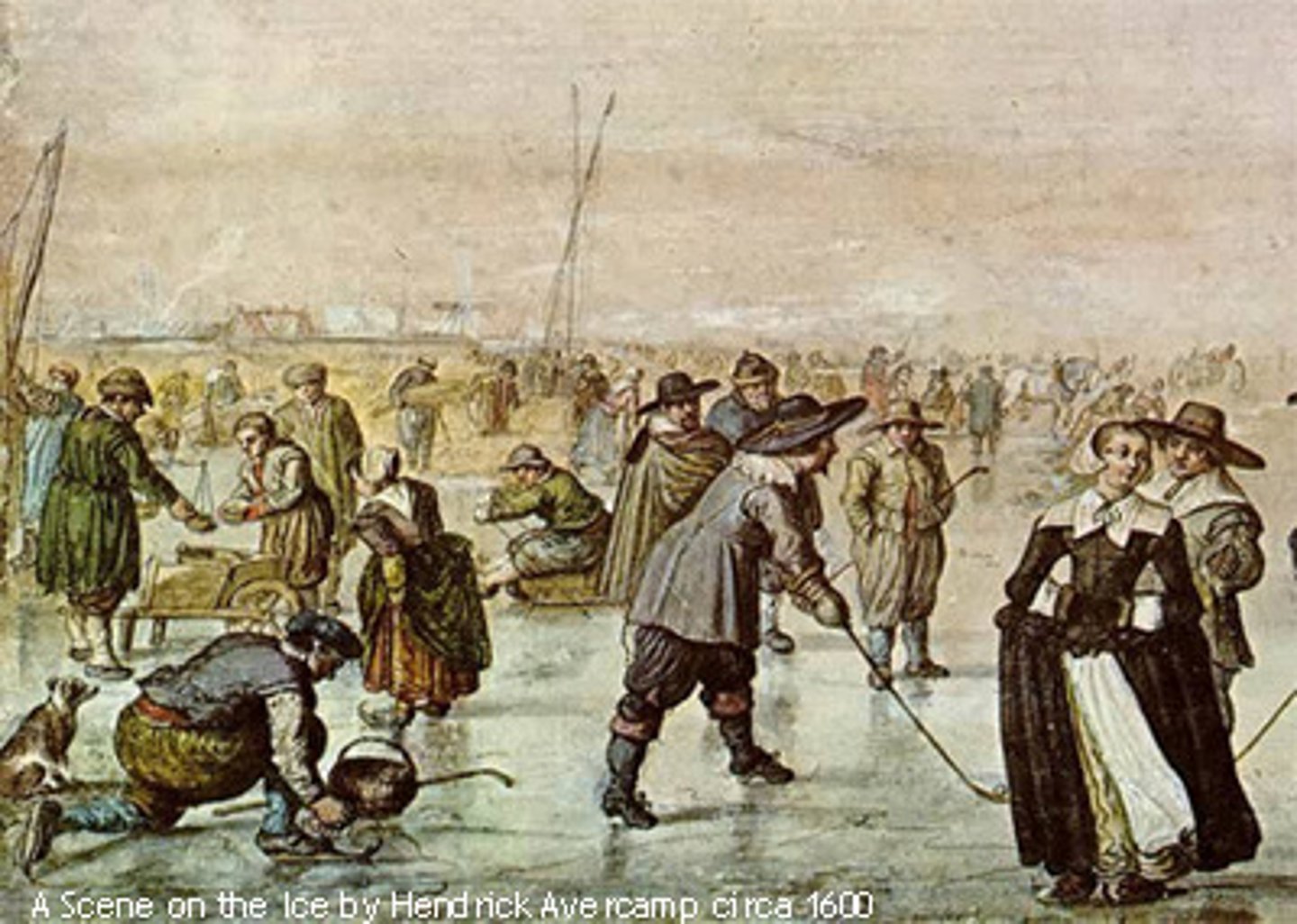
Orbital forcing
= the Milankovitch Cycles
... occur over thousands of years
1. eccentricity
2. obliquity
3. precession
When combined, orbital forcing is responsible for long term changes to earth's climate
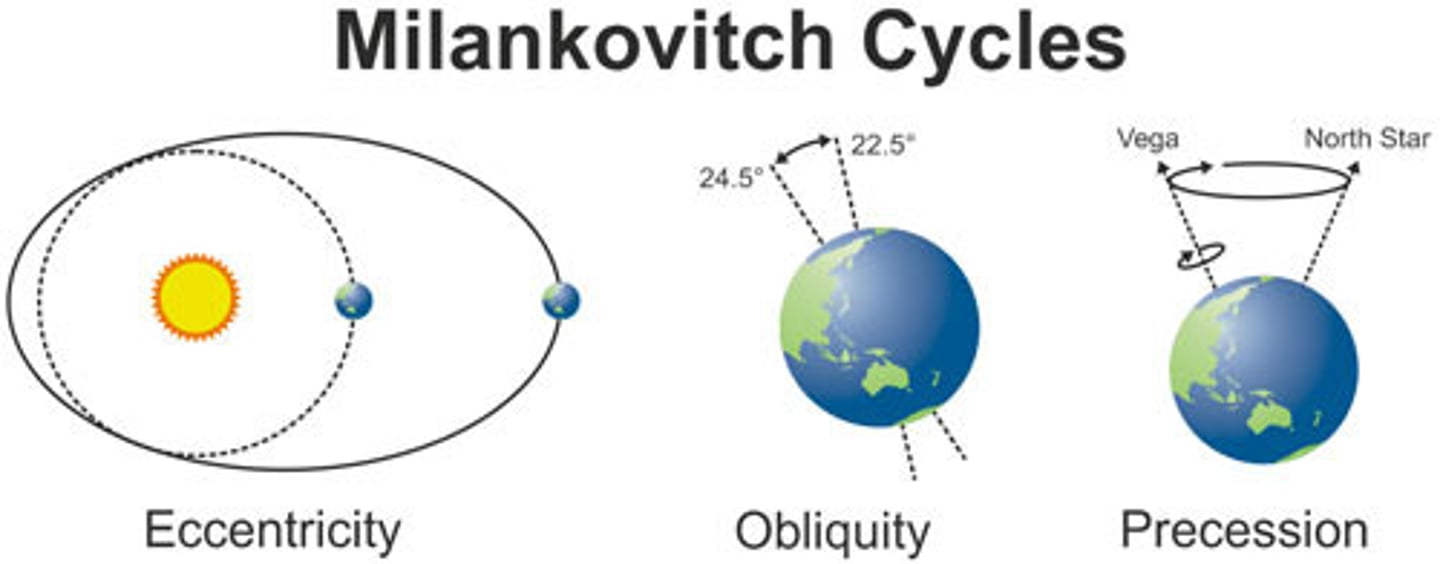
Eccentricity
... earth orbits around the sun, but shape of orbit changes
=> circular orbit to elliptical orbit
=> roughly changes every 100,0000 years
- Circular = roughly the same solar energy received throughout the year, same distance from sun
- Elliptical = different distances from sun so different solar energy received at different times of the year
... leads to climatic extremes of warming or cooling
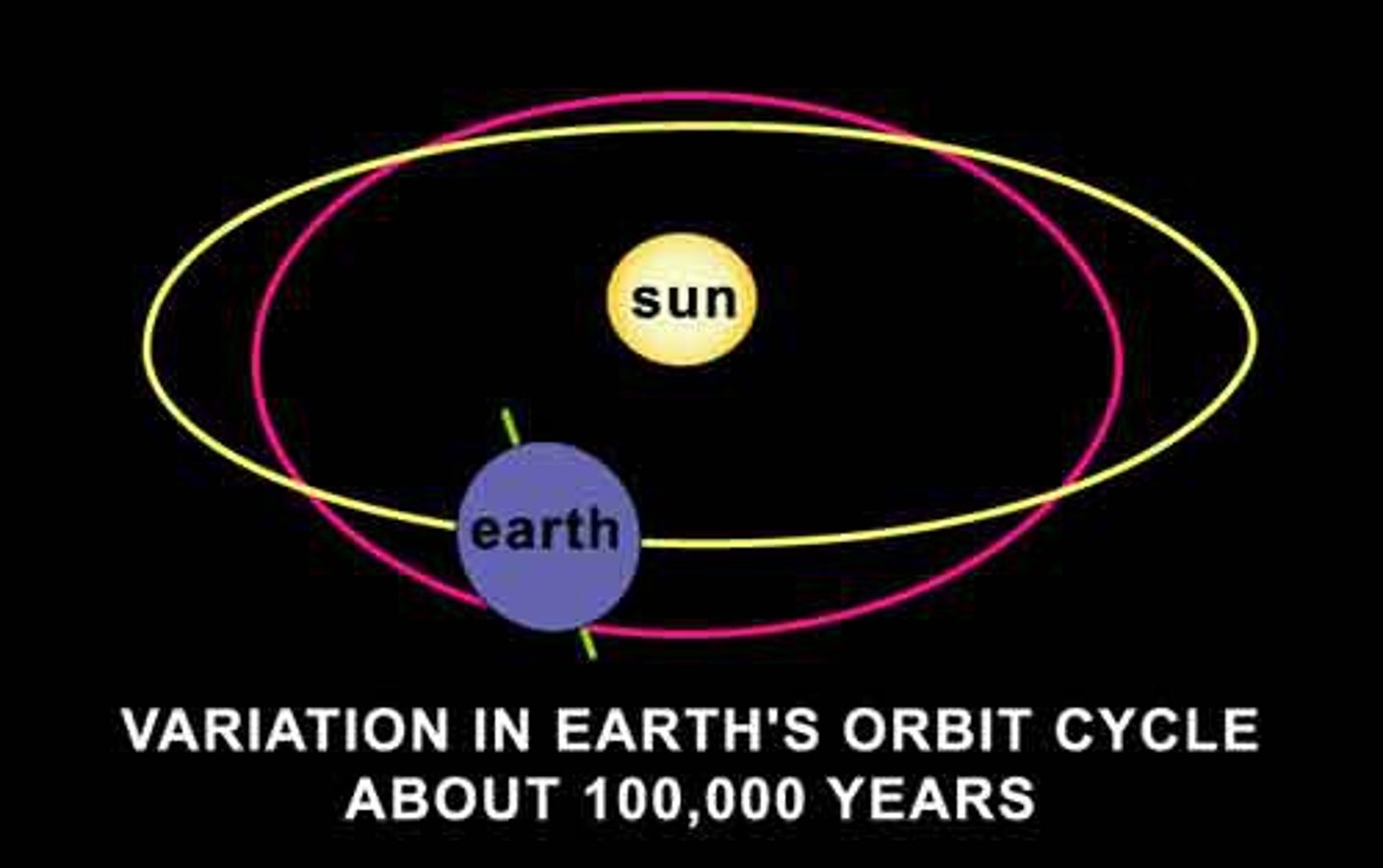
Obliquity
... angle of the tilt of the axis changes (axial tilt)
=> changes roughly every 40,000 years
=> caused by gravity of large planets pulling the earth towards them
... causes uneven heating and wind from rotation
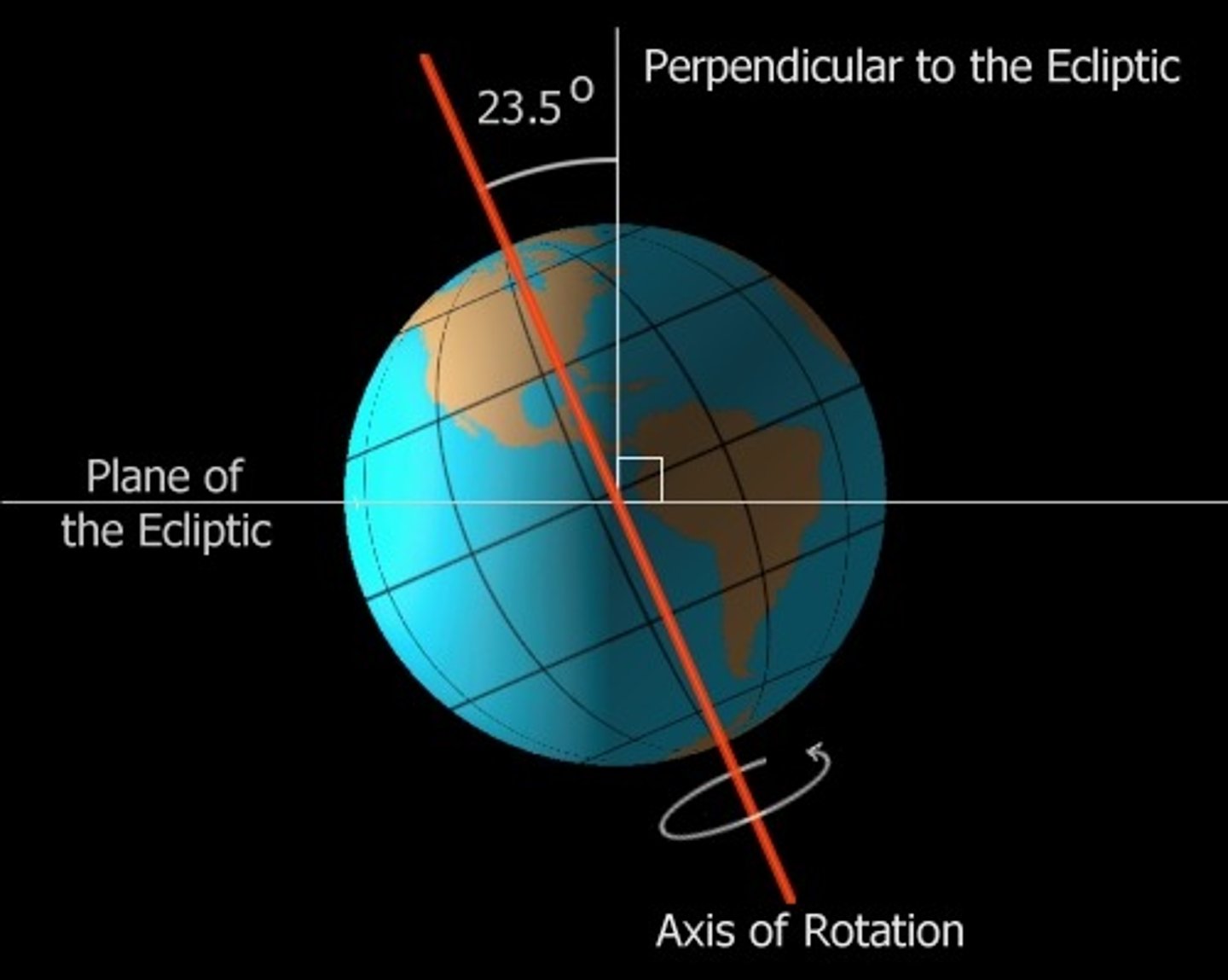
Precession
... the "wobble" of the earth
=> 26,000 years
=> affects how much solar energy each hemisphere receives every year
=> responsible for seasonal changes

external variations
Variations in earth's climate by SOLAR and ORBITAL FORCES
Temperature (solar output) and CO2 trends
Higher temperatures = higher levels of CO2 in air
= Causal relationships
- Increase in CO2 = enhanced global warming and subsequent temperature increase
- Lower levels of CO2 reduce the effectiveness of the greenhouse effect, which leads to global cooling
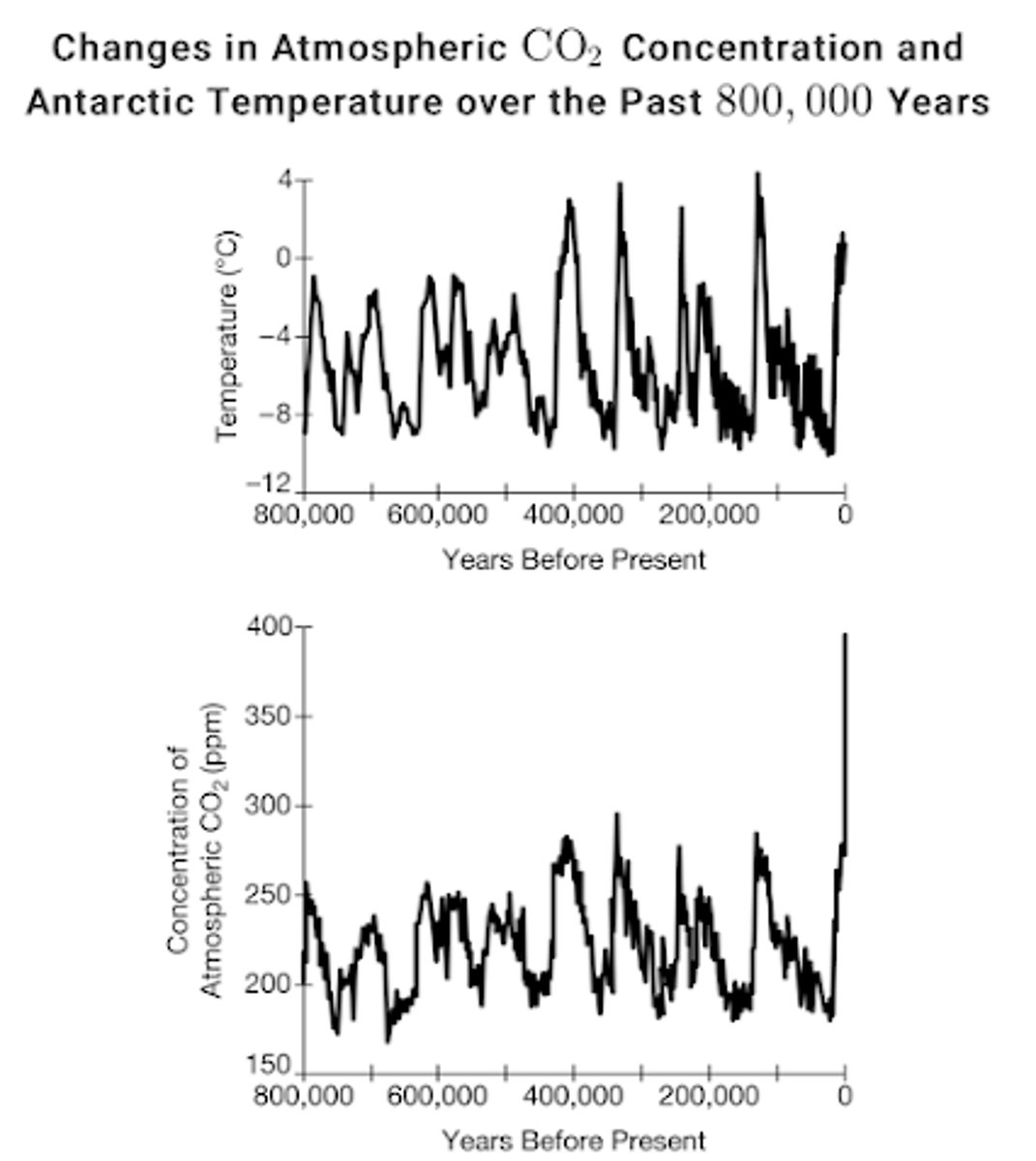
Internal Forces
= occur within the system and influence it
Volcanic eruptions
= releases carbon to the atmosphere that has been trapped for millions of years in rocks in the earth's crust
... Asteroids and volcanic eruptions trigger short term climate change that occur for months to years
- Volcanoes emit between 130-380 million tonnes of CO2 per year
- Erupt lava, containing silicates that slowly weather and convert CO2 in air to carbonates in solution (absorb CO2 from atmosphere)
- Ash is reflective and reflects radiation back into atmosphere (temporary cooling effect)
e.g., Mount Pinatubo (1991)
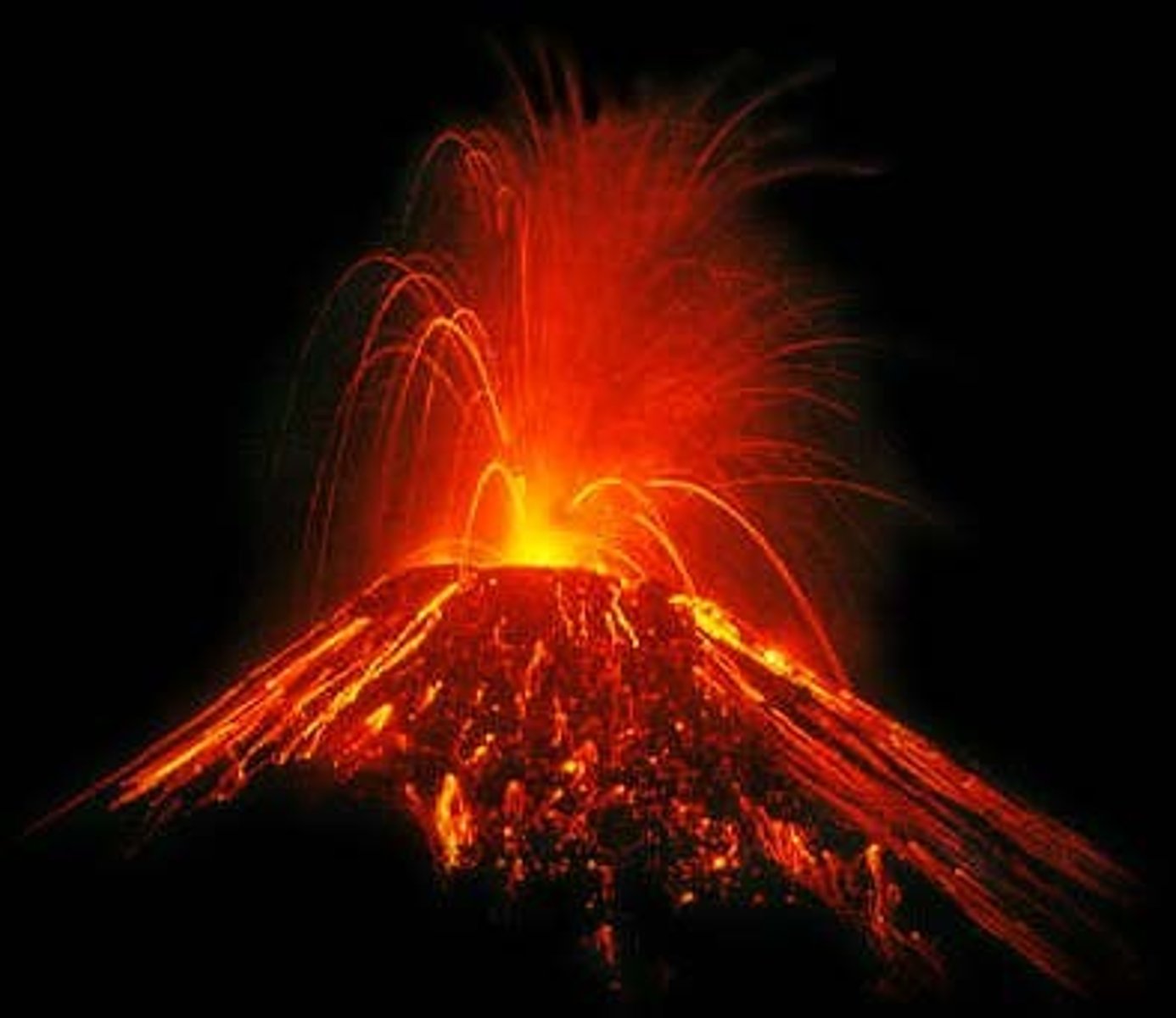
Mount Pinatubo (1991)
... released huge amounts of ash into atmosphere
Ash was reflective, reflected solar radiation back out to space
... changes earths global temperature by 1.5 degrees c for almost 2 years
(after 2 years it disperses and settles)
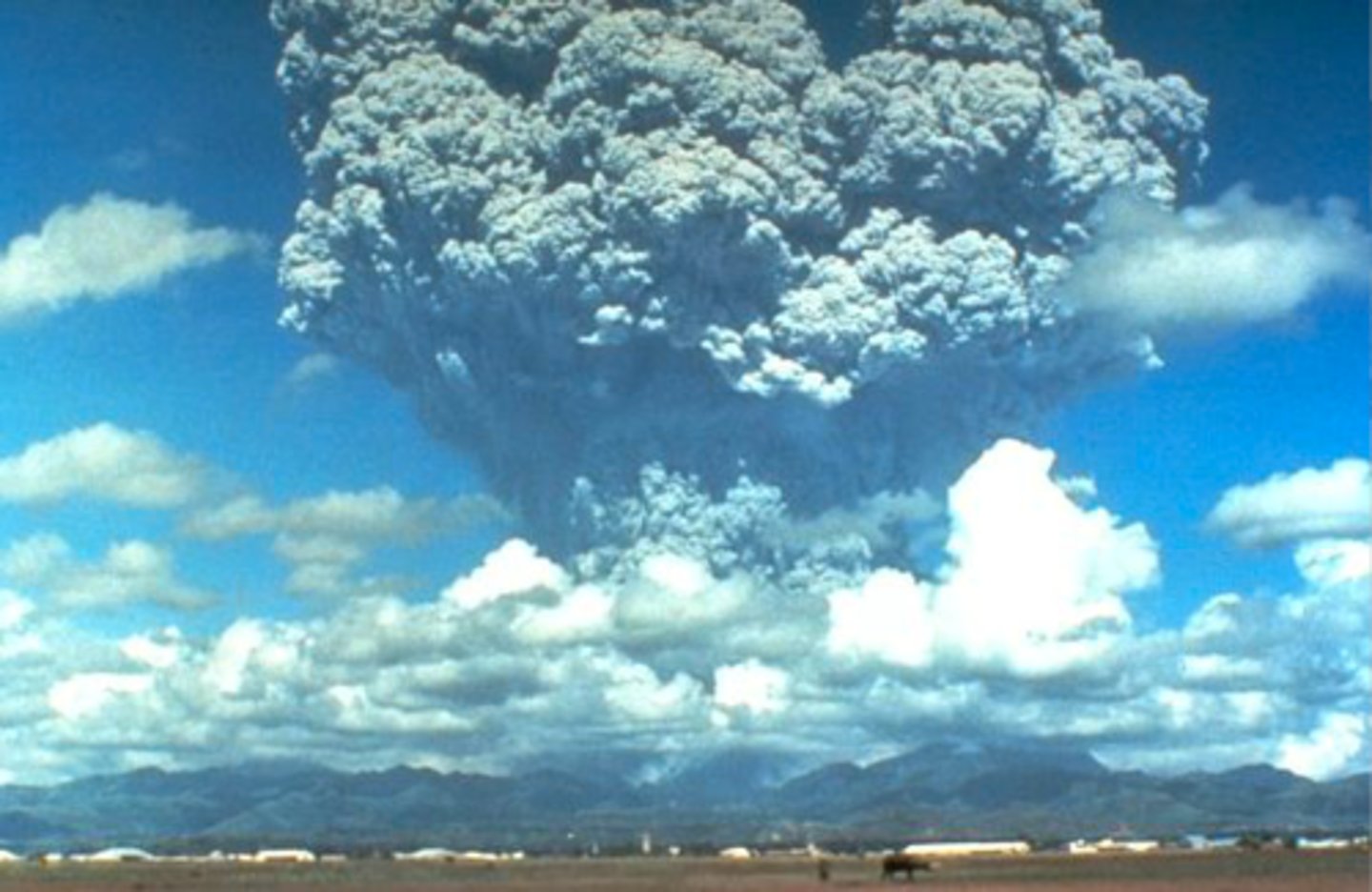
Wildfires
... turn forests from being carbon sinks to carbon sources as combustion returns huge quantities of carbon back into the atmosphere
- Naturally started by lightning strikes or deliberately started by people
- Fires release large quantities of carbon dioxide into atmosphere and increase carbon emissions
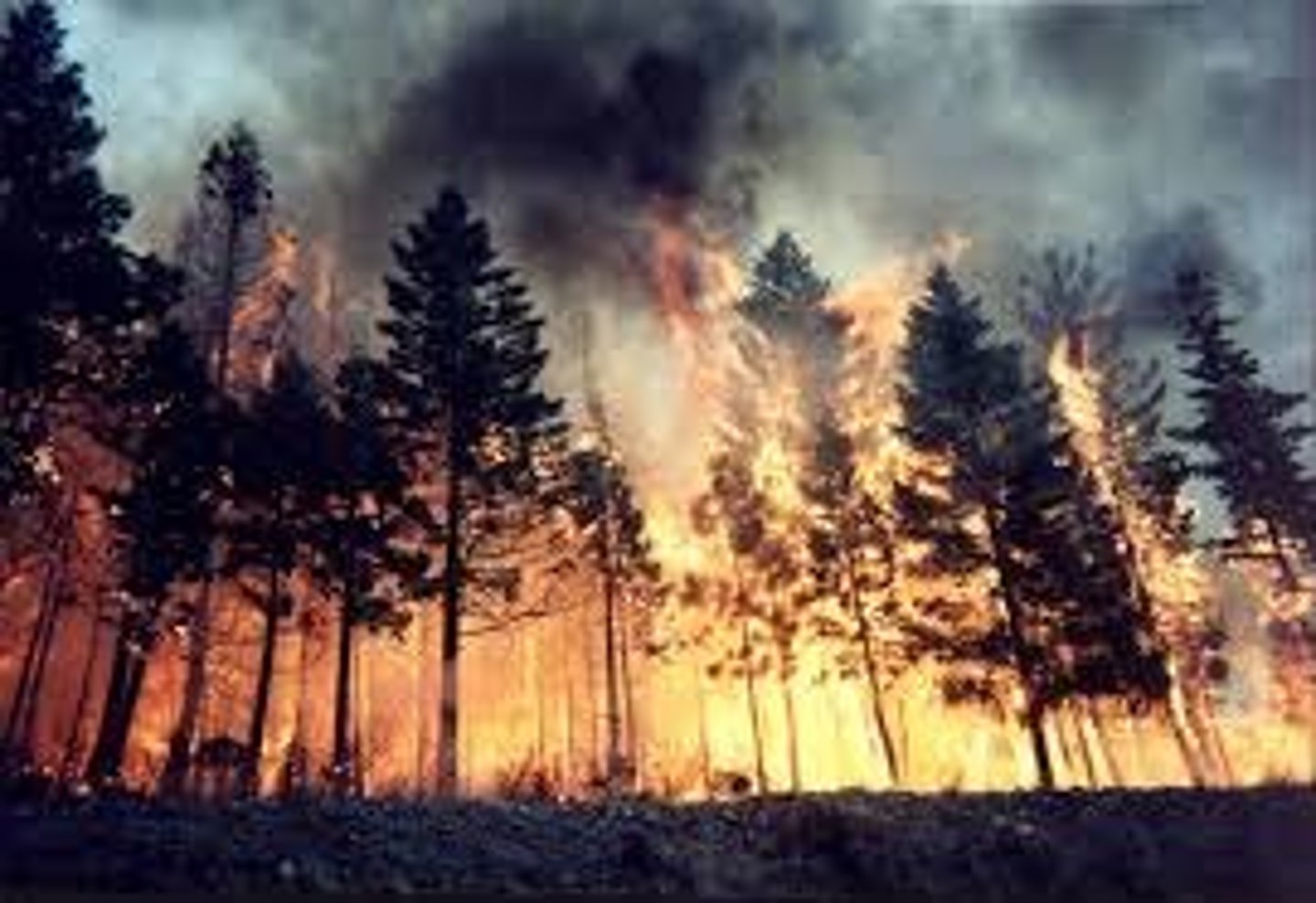
Zombie Fires
= fires continue to burn underground and smoulder in winter months under the snow
=> re-emerge early in the spring before lightning and human-caused ignitions begin again
=> fuelled by methane deposits and insulated by layers of snow
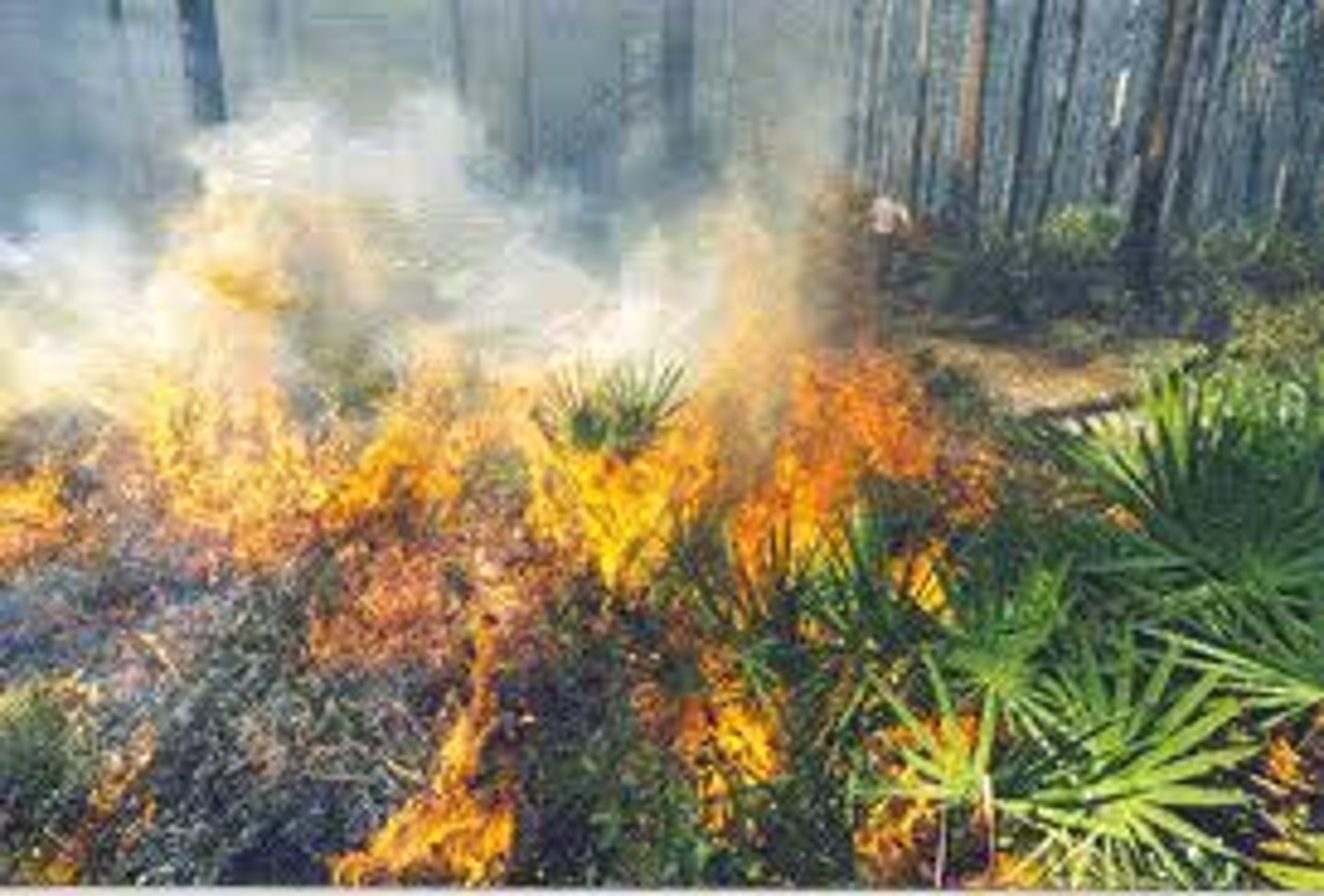
El Nino
Under normal conditions, the trade winds blow across the equator from S. America towards S-E Asia. These winds mix around the ocean waters beneath them so that cold, deep, CO2 saturated water is brought to the surface near the western coast of South America, releasing carbon dioxide into the air.
Extreme weather conditions caused by the reversal of the "normal" ocean currents
Atmospheric and oceanic circulation in the Pacific
On east pacific, cause increased rainfall (e.g., LA, Peru, Chile) = floods and landslides
On west pacific, causes drought (Australia, Indonesia) = wildfires
UK = mild winters but lots of rainfall
Becoming more frequent due to climate change
Every 5 - 7 years these trade winds weaken + trigger "El Niño," causing disruptions to natural patterns of wind + rainfall
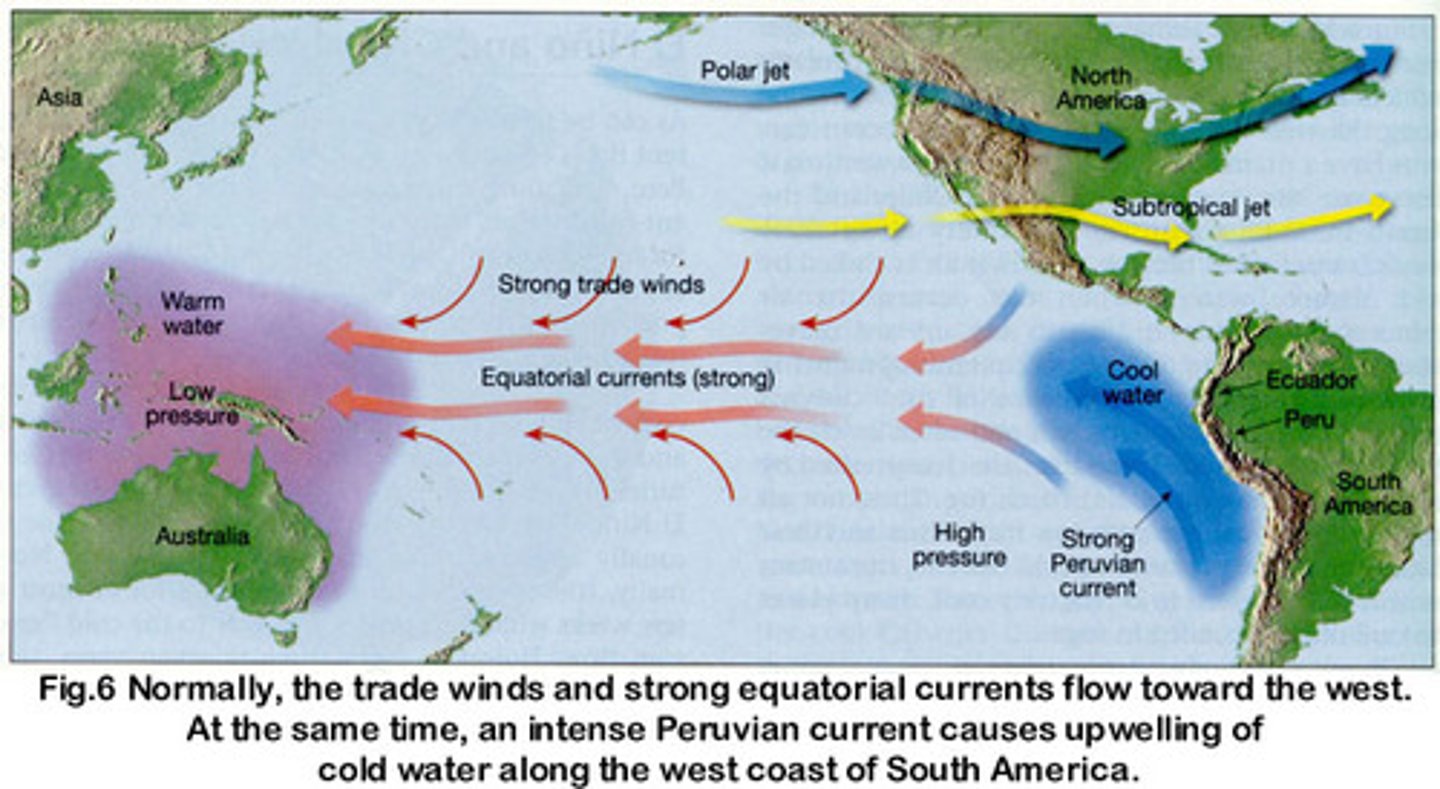
El Nino + the Carbon Cycle
The weakening of the trade winds reduces the amount of deep, cold, carbon-rich water brought to the surface along the coast of South America,
=> suppresses the amount of CO2 the ocean would normally release to the atmosphere
=> during El Niño, S-E Asia experiences unusually warm and dry conditions causing forest fires and peat bog fires that release an immense amount of CO2 into the atmosphere,
=> CO2 release from fires > reduction in oceanic release of CO2
=> Plants take up less CO2, warm and dry conditions contributed to biomass burning through S-E Asia and Indonesia, releasing massive amounts of CO2 into the air
The impact of cold conditions on carbon stores & transfers - Chemical Weathering Processes
... would be more active in cold weather as cold water can hold more CO2
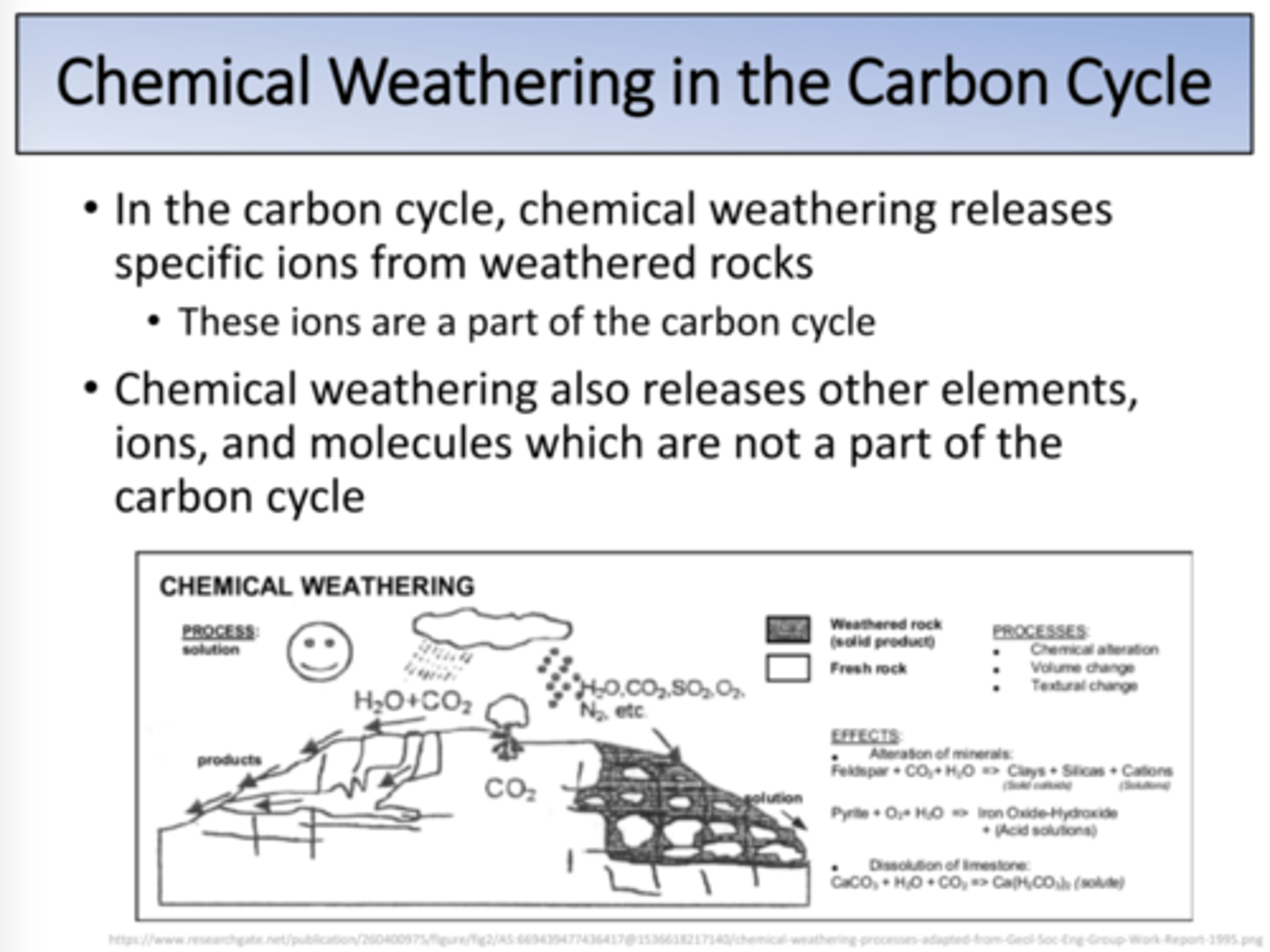
The impact of cold conditions on carbon stores & transfers - Forest Coverage
... would affect forest coverage in many geographical locations and total area as would affect photosynthesis and respiration processes + their distribution
The impact of cold conditions on carbon stores & transfers - Decomposers
... would be less effective so carbon transfer to soils would be reduced
The impact of cold conditions on carbon stores & transfers - Water Cycle
... less water would flow into oceans as it is locked up as snow/ice on land
... less sediment transfer along rivers and less build-up of sediments on ocean floor
The impact of warm conditions on carbon stores & transfers
Melting of permafrost in tundra areas
e.g., Russia, Siberia
- Carbon stored within the permafrost would be released along with methane and other gases
- This further enhances greenhouse effect, leading to increased warming
= positive feedback
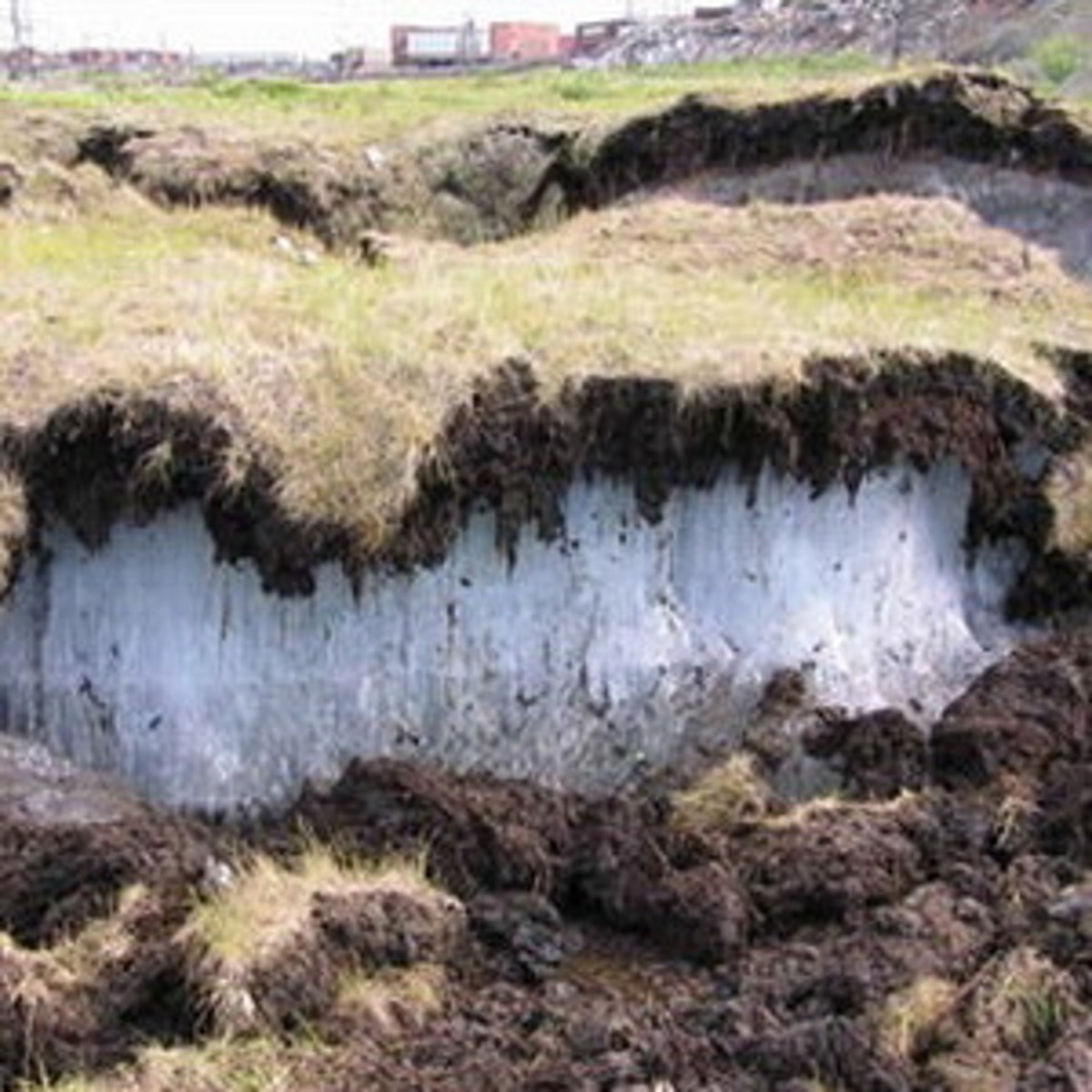
The impact of cold conditions on carbon stores & transfers - Soil and Nutrient Cycle
... soil would likely be frozen over vast areas of land, stopping transfer of carbon
Human Causes of change
- Combustion of fossil fuels
- Land use change
- Agricultural practices
- Deforestation
- Urbanisation
The effect of human activity on the carbon cycle
About 87% of anthropogenic carbon release comes from the combustion of fossil fuels
(Burning of coal, oil, and natural gas)
Remaining 13% = land-use change (deforestation) land drainage, and agricultural practices
Roughly ½ of the anthropogenic carbon is absorbed equally by oceans and vegetation
=> remainder is absorbed by atmosphere
Changing global concentrations of CO2
Since the 1960's global concentration of carbon dioxide has increased from 320ppm to 419ppm
= the highest level ever recorded
(150 years ago = 280ppm)
... change = due to industrial revolution with an increased dependency on burning of fossil fuels for energy
The combustion of fossil fuels
- Hydrocarbons
- Oil
- Natural Gas
- Coal
- Methane
- Deep Gas
- Fracking
- Geopressured Zones
- Artic Methane Hydrates
The combustion of Hydrocarbons
Hydrocarbon extraction and burning
= most oil and gas are extracted from millions of years old rocks
e.g., cement manufacturing
Principle material in concrete (used everywhere)
... accounts for 5% of all man-made carbon emissions
The heating of limestone, produces lime and CO2 as a by product
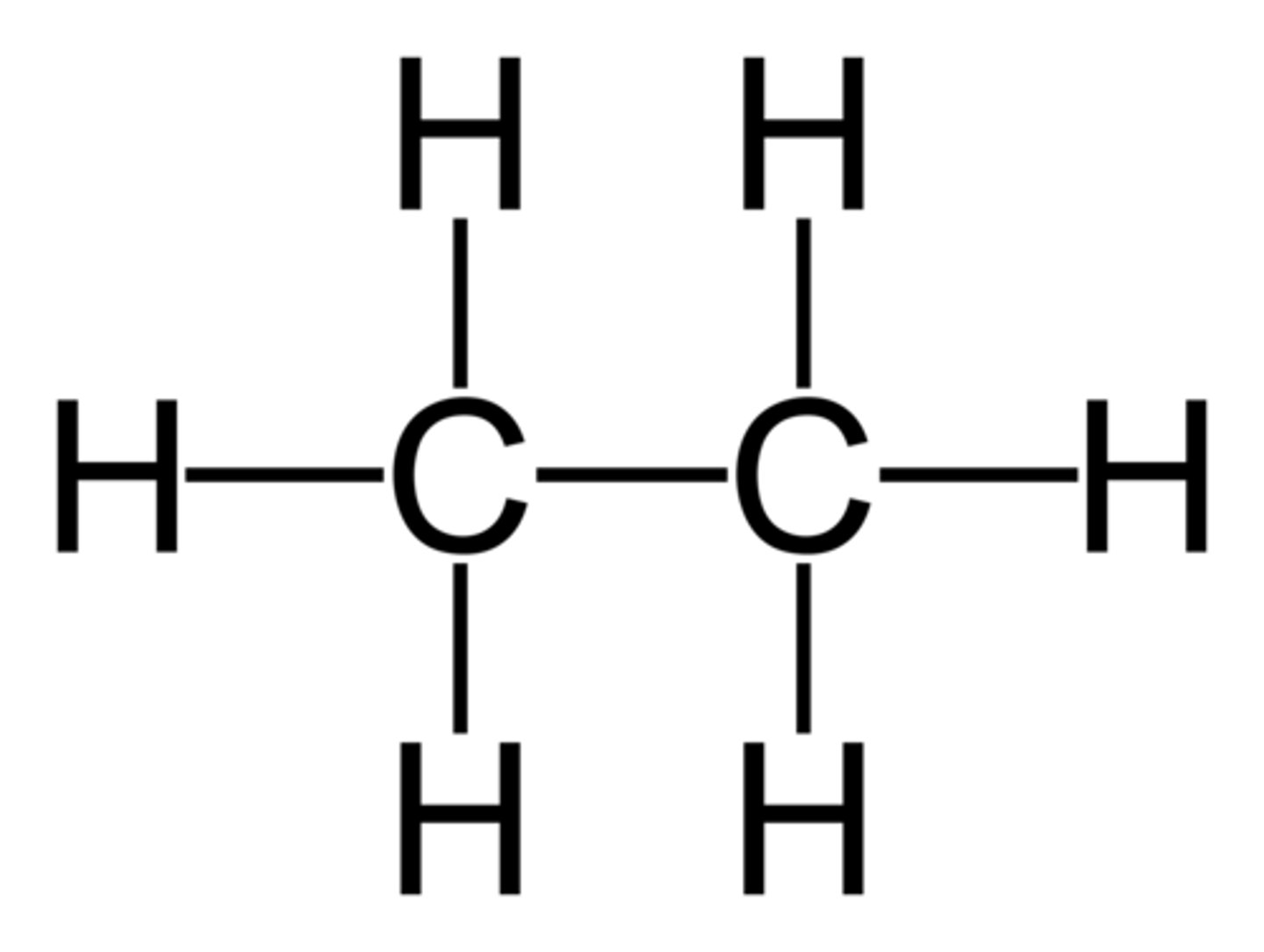
The combustion of Oil
= the most useful
- 36% of all global fossil fuel CO2 emission
... produces about 20% less CO2 than coal in combustion
HOWEVER
... oil extraction can be environmentally damaging in other ways such as oil spills
e.g., Deepwater Horizon accident (2010), Tar Sands extraction (Alberta, Canada)
... proven oil reserves are good for around 50 years

The combustion of Natural Gas
= produces 40% less CO2 than coal in combustion
... 20% of all global fossil fuel CO2 emission
... linked to fracking for shale gas and environmental damage
... proven gas reserves are good for around 50 years
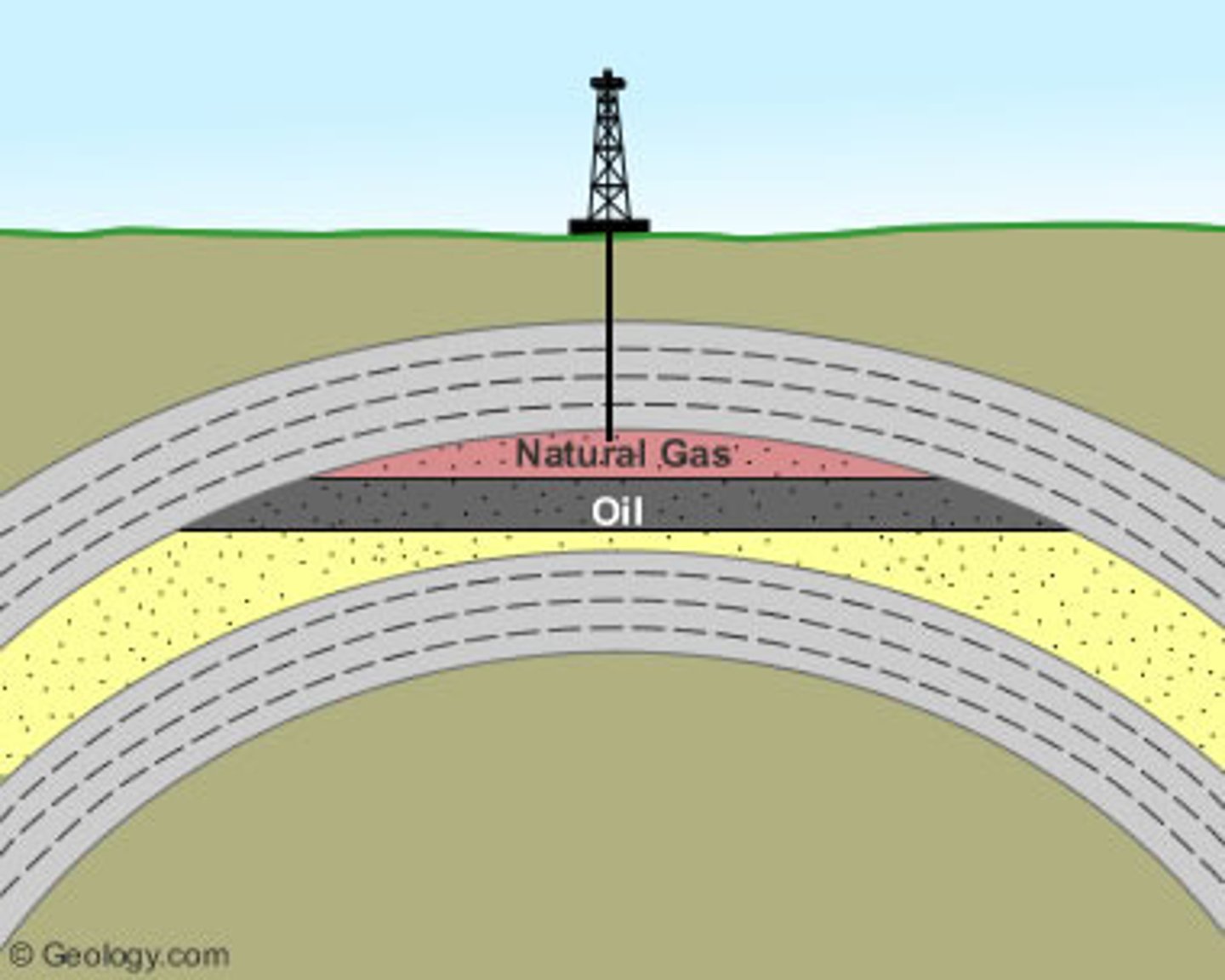
The combustion of Coal
= has highest carbon footprint of any fossil fuel
... responsible for 43% of all global fossil fuel CO2 emissions
... proven reserves of coal are at least 150 years
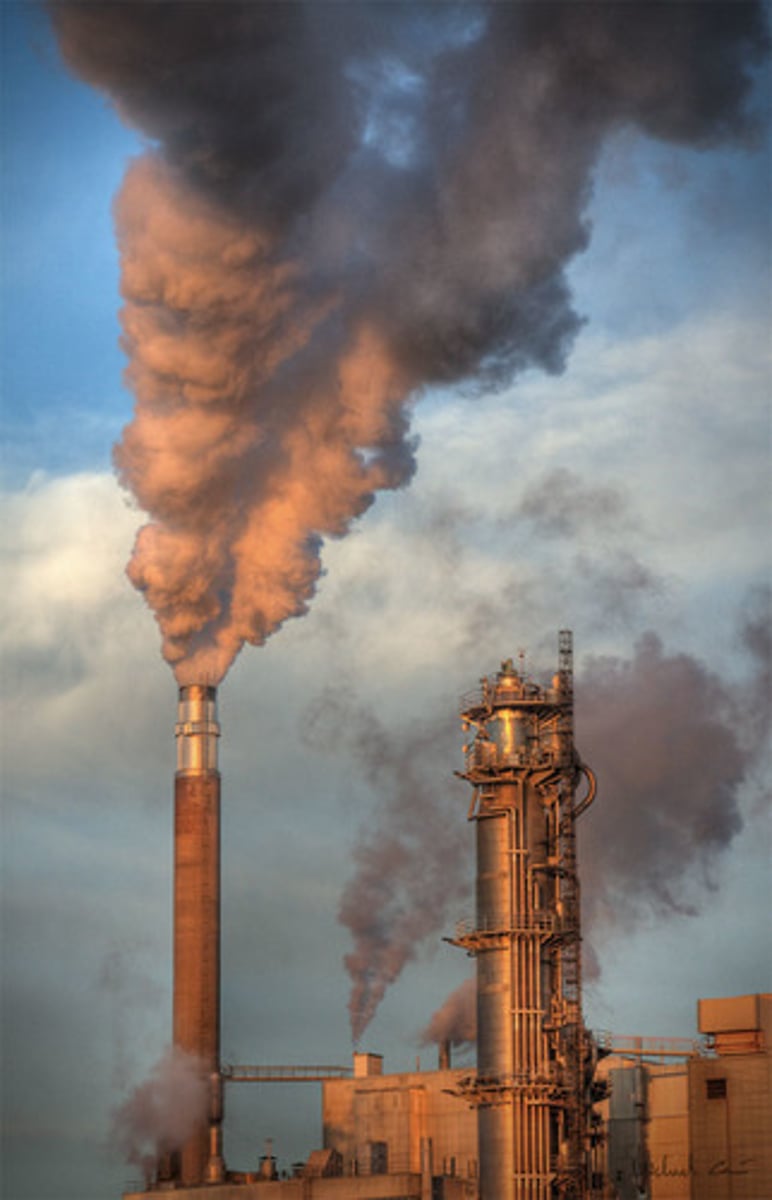
The combustion of Methane
= greenhouse gas 30x more harmful than CO2
e.g., paper, food waste, biomass, energy
... 1kg of Methane produces 25kg of CO2
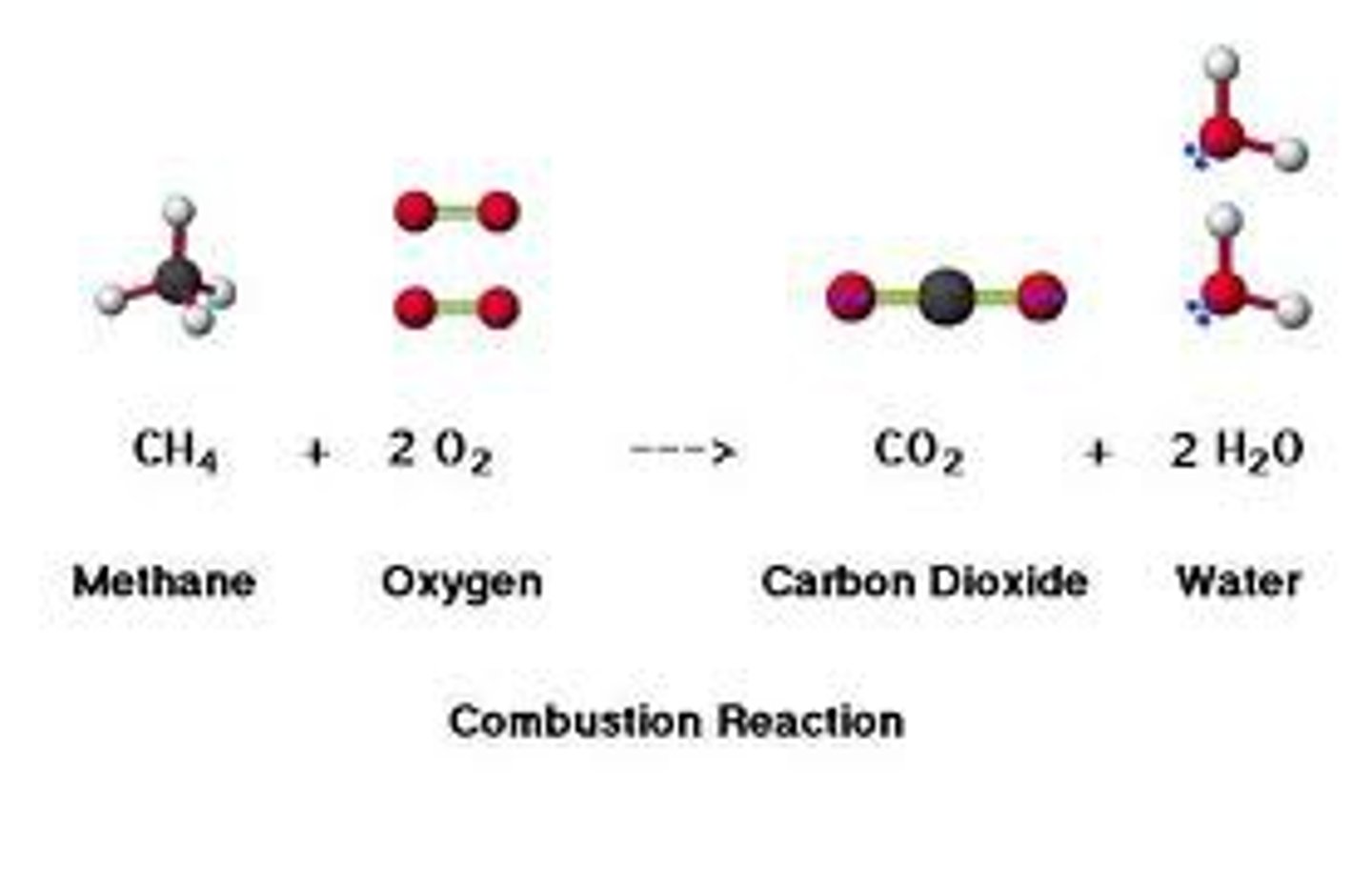
The combustion of Deep Gas
= deposits deeper than 5,000m beyond conventional drilling depth
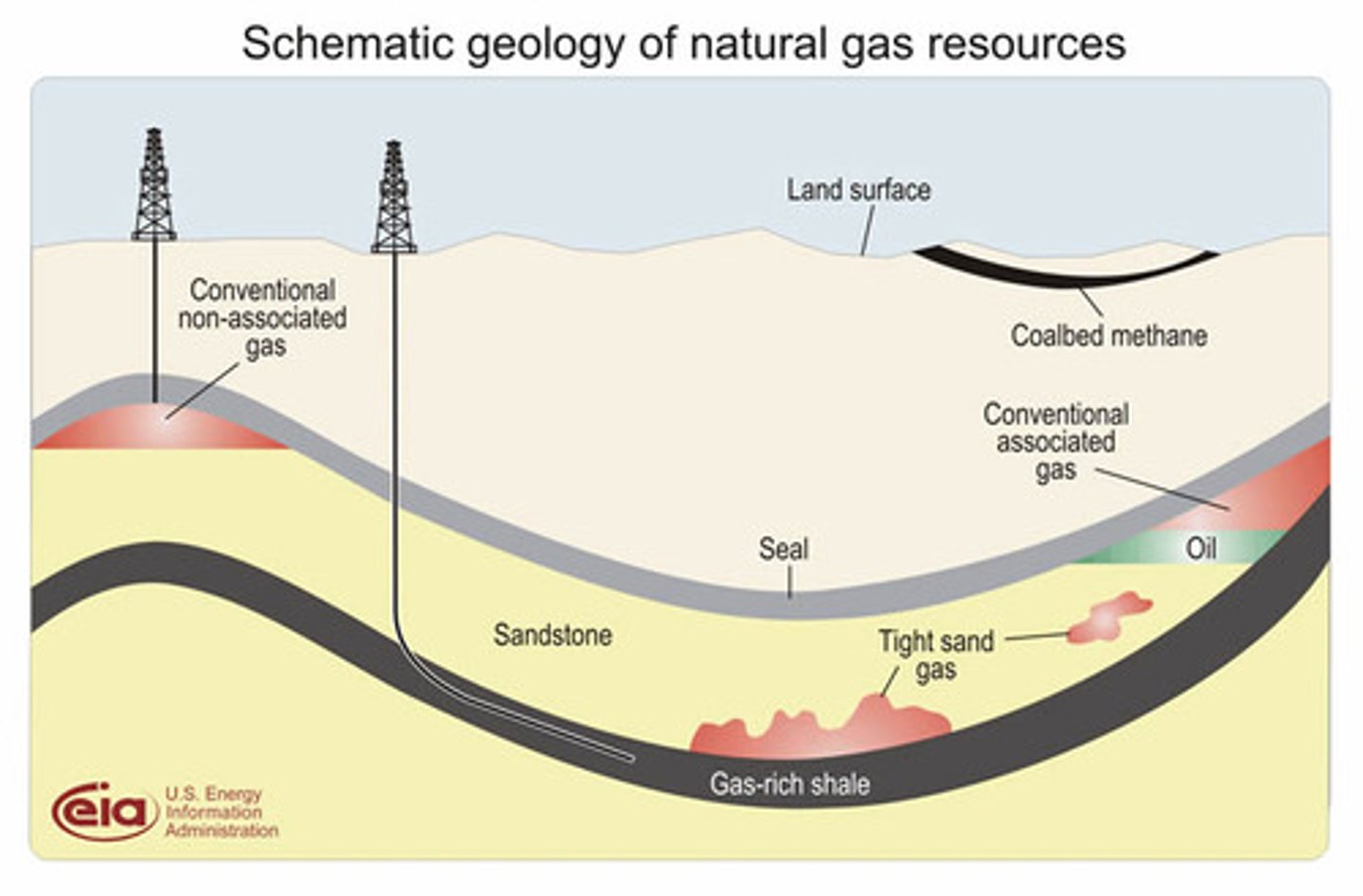
The combustion of Fracking
= uses toxic liquid to squeeze shale gas out of less permeable rocks
(e.g., sandstone)
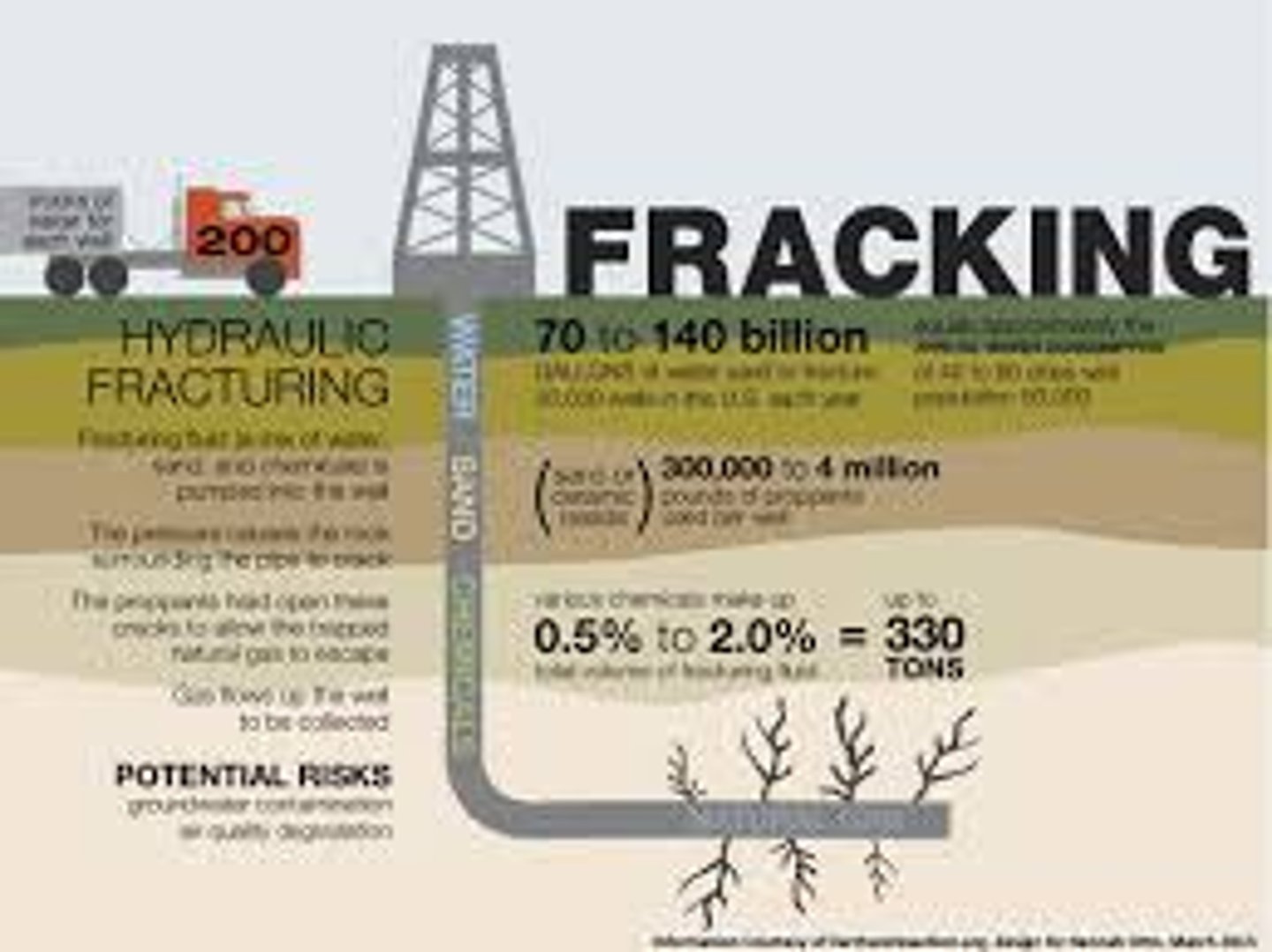
Combustion & Geopressured Zones
= bands of compacted clay containing oil and gas
... extraction will become more and more common in these areas, leading to mass environmental damage
The combustion of Artic Methane Hydrates
= frozen water (permafrost) surrounding molecules of methane
... estimates suggest that methane hydrates may contain more carbon than all the worlds coal, oil and conventional gas combined
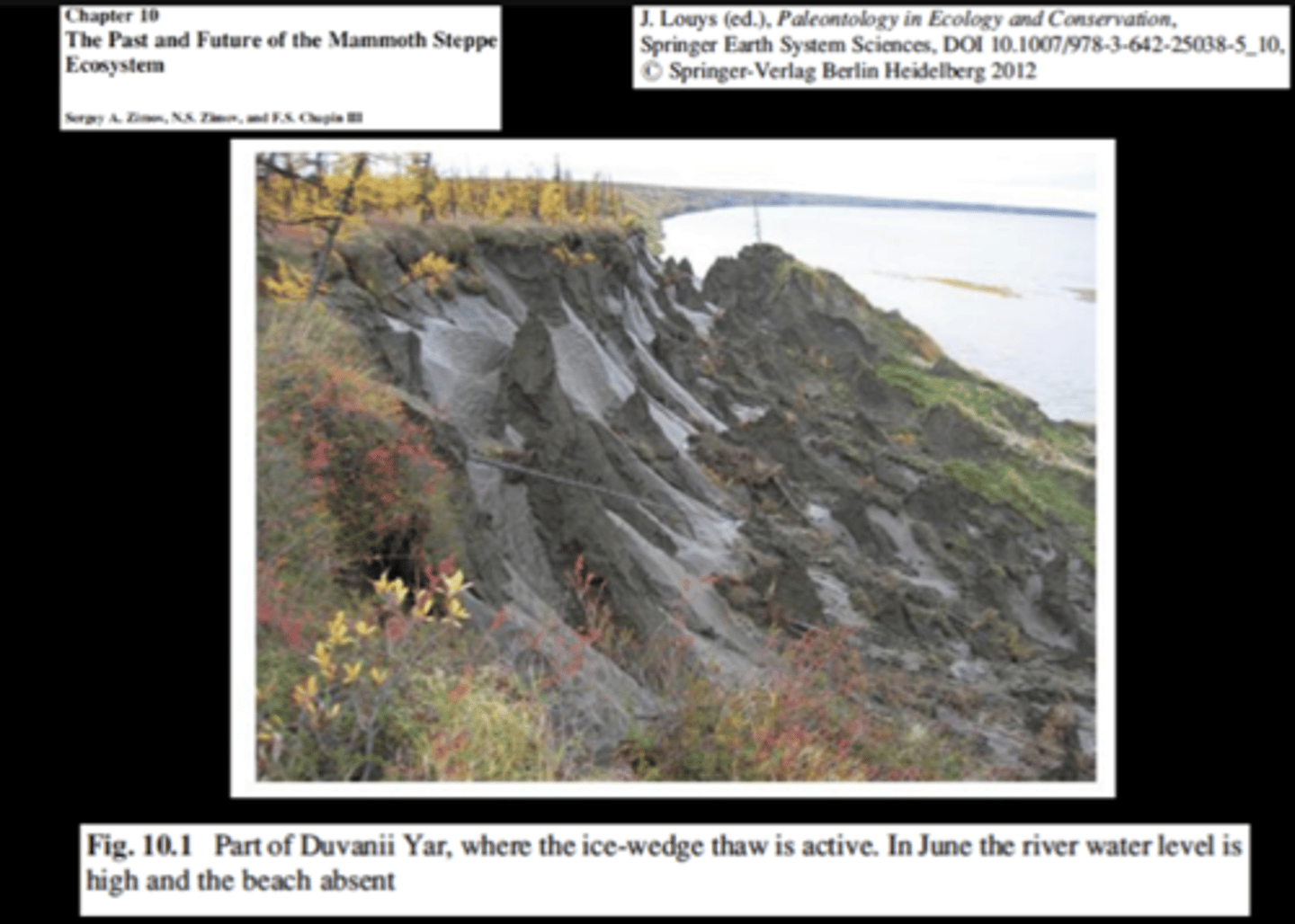
Problems with energy and fossil fuels
Energy Security = a key goal for countries that rely on fossil fuels
... since 2004 there has been an era of energy insecurity
- Increased demand in NEEs (China, India, Brazil)
- Decreasing Reserves linked to the concept of Peak Oil (year that global oil production reaches max and enters long term decline)
- Global Warming leads to movements away from fossil fuels
- Geopolitical Developments e.g., Russia's resources and Europe's embargo after Ukraine invasion
- Terrorist Activity in Nigeria and Iraq affecting oil outputs
Land Use Change
= responsible for 10% of carbon release globally
... impacts relatively short-term stores and has direct links to issues of climate change and global warming
... on a local scale, land use changes can have a very significant impact on small scale carbon cycles
Agricultural Practices
¼ of CO2 emissions comes from agriculture and food production
When soil is ploughed, it is aerated and exposes the area to microbial activity
- more humus is broken down into nutrients, producing more CO2 rapidly
(aerobic conditions = CO2 produced)
Enteric Fermentation
... livestock is producing methane during digestion
e.g., cattle account for 20% of total methane emissions in USA
e.g., Cattle in the USA emits around 5.5 million tonnes of methane per year
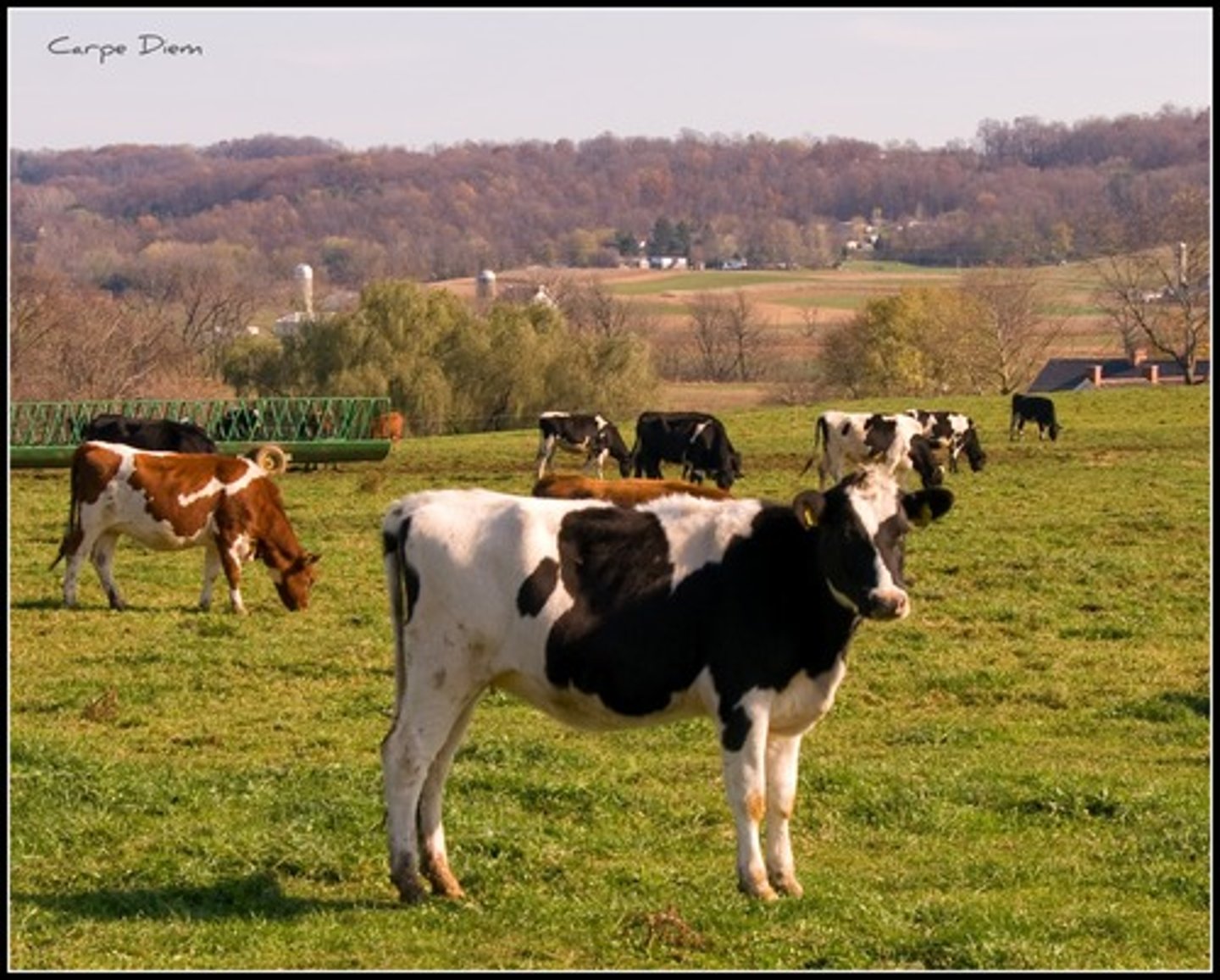
Rice Paddies
Rice Paddies create CH4 during anaerobic decomposition
- 10% of total agricultural emissions = methane from Paddy fields
- rice yields have increased by 25% with more CO2 in atmosphere (N. America & Asia) but this had resulted in a 40% increase in methane emissions
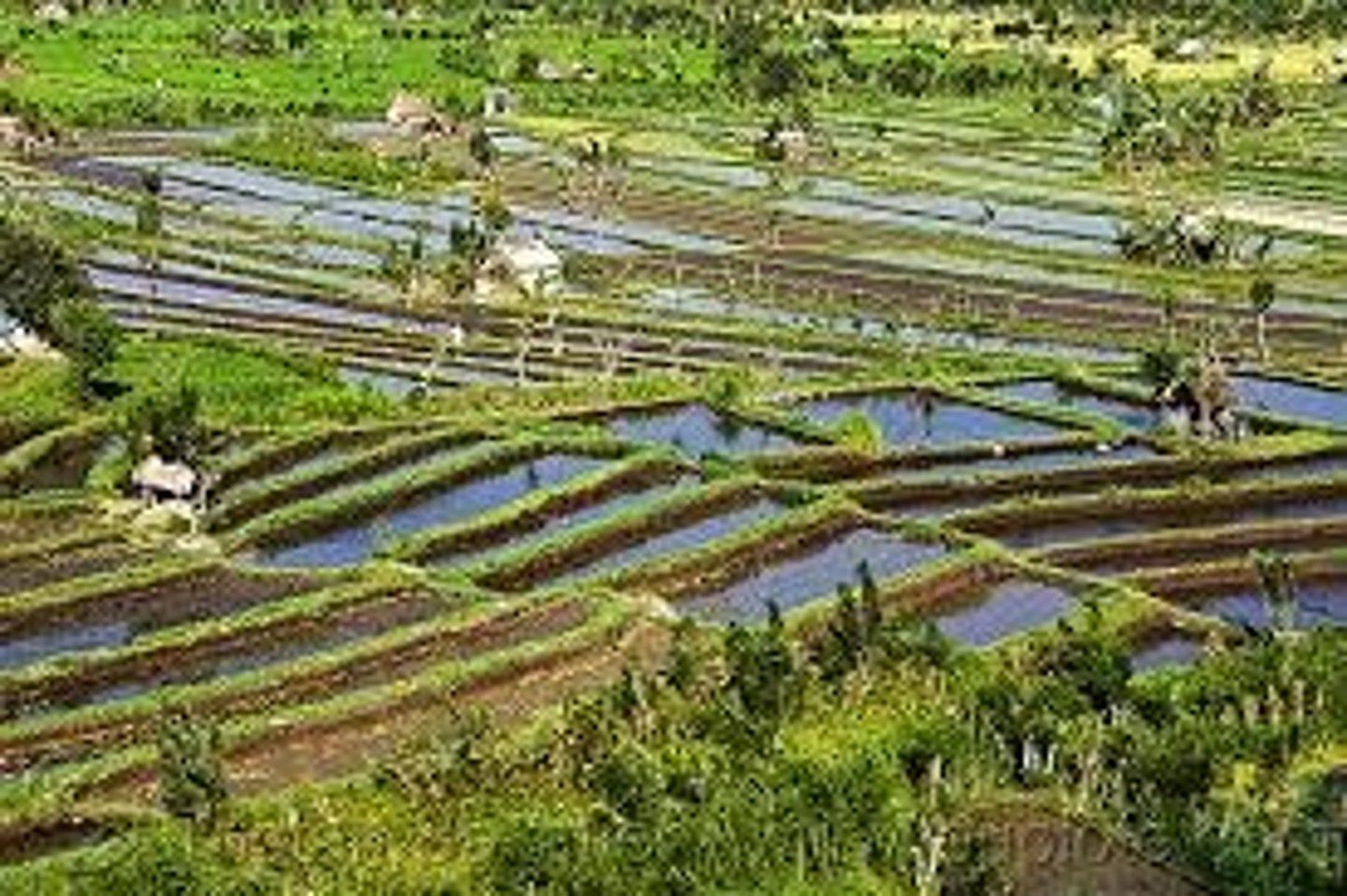
Burning tropical grasses
= accounts for 5% of total agricultural emissions
Use of fertilisers
= artificial fertiliser is one of the main sources of carbon emissions on many farms

Deforestation
= mostly driven by need for farmland - particularly livestock
... in total, accounts for about 20% of all global carbon dioxide emissions
- Carbon is immediately released when trees are cut down
- Future absorption of carbon dioxide is reduced when land is used for other purposes e.g., cattle ranching
o Slash and burn agriculture
o Logging operations
... FAO states that an area the size of Greece of the world's forests are converted to other land uses per year
1990 - 2000: 8.9 million hectares of forest lost per year
2000 - 2005: 7.3 million hectares lost per year

Urbanisation
... replacing open countryside with concrete and tarmac
- Important carbon stores are either replaced (vegetation) or covered up (soils) with impermeable surfaces
- Globally, urban areas occupy about 2% of the total land area
... These areas account for 97% of all anthropogenic CO2 emissions
- Transport
- Land use/space
- Resource consumption (food, timber, energy)
- Construction (cement - emits CO2 as by product)
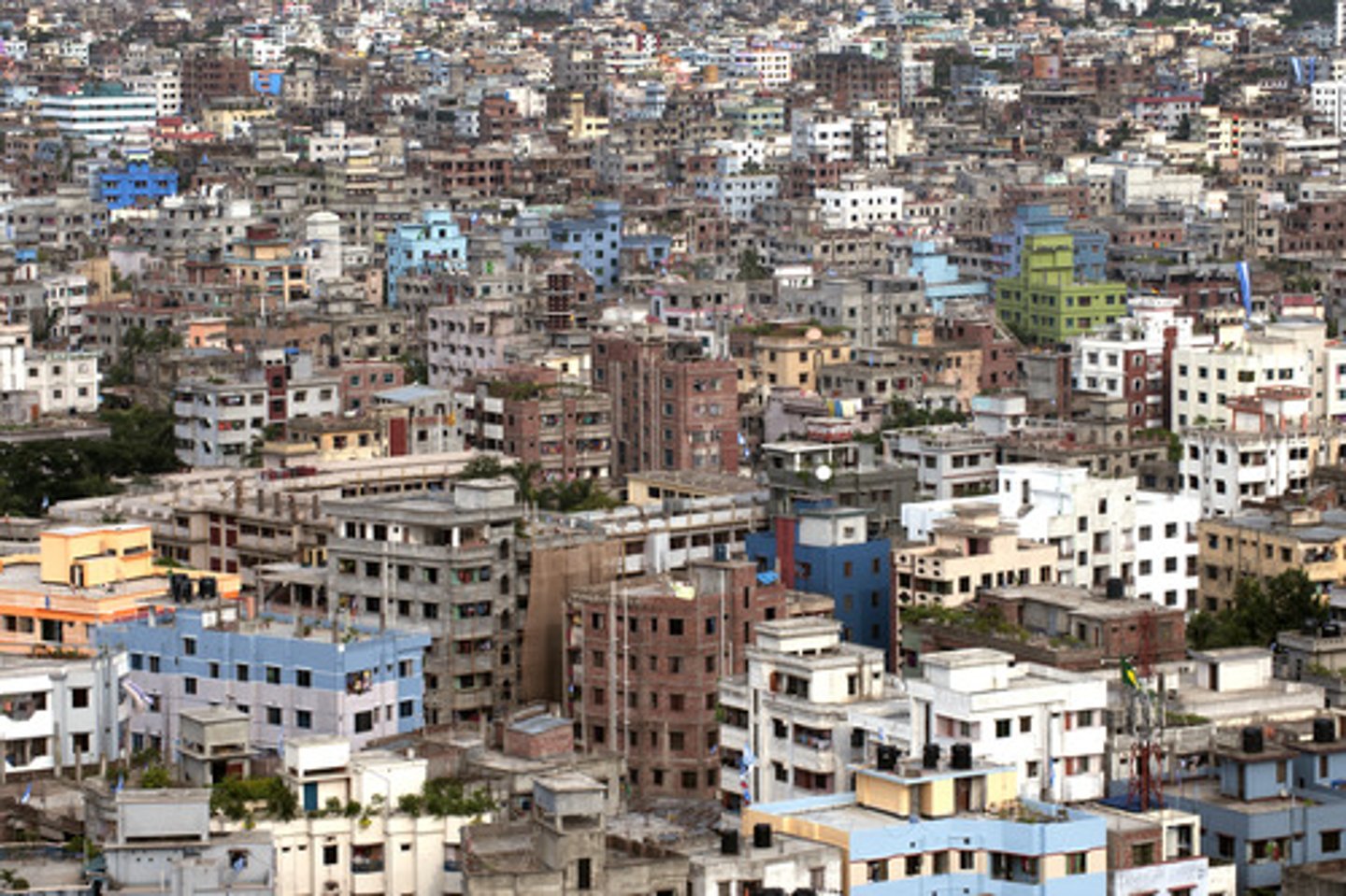
Urbanisation + future population growth
60% of global population will live in urban areas by 2030
...most likely to become the most sustainable places in the world before any other area due to investments, technology, and priority
... lowest carbon footprint in UK = Londoners - public transport + proximity, no need for cars
Root Cause of changes to the carbon cycle
ROOT CAUSE = dumping slow rate carbon stores into the fast rate carbon cycle
Carbon cycle cannot cope with this transfer of carbon
bridged two parallel carbon cycles that shouldn't be mixed